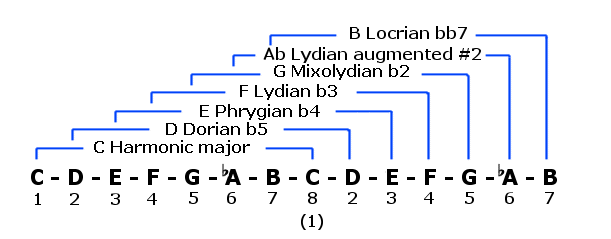

This is because, in the briefest and simplest terms possible, tonality is essentially defined by the V7-I cadential relationship, which lives and dies on the resolution of the “tension” inherent in the tritone. For tonality to be functional melodically and harmonically, you have to have a leading toneįor tonality to be functional melodically and harmonically, you have to have a leading tone as the 7 th scale degree (the 7 th note of the scale has to be a major 7 th above the root, or a half-step below the tonic – however, you want to visualize it). The “harmonic” label comes from the fact that, in the language of Western “classical” music theory, the harmonic minor scale has all of the elements necessary for generating tonality, i.e. To understand the derivation of the harmonic major, we have to briefly explain where harmonic minor scales come from. C harmonic major is spelled: C-D-E-F-G-Ab-B-C. It’s essentially like a harmonic minor scale, except it has a natural (not a flatted) 3 rd scale degree, as you would assume for any scale labeled “major.” In other words, it’s a major scale with a flatted 6 th degree. And it works for both major and minor II-V’s (details on that below)!įirstly, what is the harmonic major scale? In my experience, relatively few jazzers talk about or teach this scale, but it is possibly the single best scale to use if you want a simple and concise tool to help you start generating bebop vocabulary over II-V-I’s.


I’ve already briefly delved into bebop scales here on the LJS site before, and in this post, I want to talk about another lesser known or “secret” scale: the harmonic major scale. Or, on the other hand, we often hear that you can treat the whole II-V-I as essentially one scale all based off of the Ionian (major) mode played from the root of the I chord.Īlthough these are sometimes useful approaches and can offer a very basic framework to help novice jazzers get started with improvisation, I think there are even better ways to conceptualize II-V-I’s regarding specific scale choices. We’re told the II-7 chord corresponds to a Dorian minor scale, the V7 a Mixolydian dominant scale, and the I(maj7) either a Lydian or Ionian scale. Most of the time, II-V-I’s are taught as a set of discrete modes or as a collection of related modes derived from a single parent scale.


 0 kommentar(er)
0 kommentar(er)
